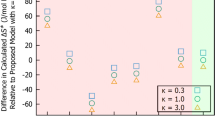Abstract
The corrosion of metallic components is a significant problem in many high temperature processes. In studying such corrosion phenomena, the scientist must identify simpler laboratory environments which can reproduce the corrosion product composition and morphology found in the more complex service environments. The present work was undertaken to develop a graphical method to aid in accomplishing the above objective. A predominantly oxidizing-sulfidizing environment which also contains some carbon was selected as an example. Such an environment is characteristic of processes such as coal gasification and can be produced by mixing CO2, H2, and H2S in appropriate quantities. Starting from selected initial compositions of such gas mixtures, an approach based upon free energy minimization was used to determine which condensed corrosion product phases will be stable for selected metals, temperatures, and total pressure. Graphs with initial CO2/H2 and H2S/H2 ratios as axes were then constructed; in these graphs, areas represent single condensed phases, lines represent two condensed phases in equilibrium, and triple points represent three condensed phases in equilibrium. The graph indicates at a glance the product phases which are possible for a given initial gas composition. When dealing with alloys, diagrams for the component pure metals must be combined.
Similar content being viewed by others
Rerences
I. Barin and O. Knacke,Thermodynamic Properties of Inorganic Substances (Springer-Verlag, Berlin, 1973); I. Barin, O. Knacke, and O. Kubaschewski,Thermodynamic Properties of Inorganic Substances, Suppl. (Springer-Verlag, Berlin, 1977).
W. B. White, S. M. Johnson, and G. B. Dantzig,J. Chem. Phys. 28, 781 (1958).
P. S. Hagan, private communication.
T. Rosenqvist,J. Iron Steel Inst. 174, 37 (1954).
M. W. Chase, J. L. Curnutt, A. T. Hu, H. Prophet, A. N. Syverud, and L. C. Walker,J. Phys. Chem. Ref. Data 3, 311 (1974).
R. A. Perkins, inProc. Conf. Corrosion/Erosion of Coal Conversion System Materials, A. V. Levy, ed. (NACE, 1979), pp. 351–382.
K. Natesan, Ref. 6, pp. 222–270.
Author information
Authors and Affiliations
Rights and permissions
About this article
Cite this article
Srolovitz, D.J., Ramanarayanan, T.A. Thermochemical diagrams for metal-oxygen-sulfur systems: An aid in corrosion research. Oxid Met 22, 247–275 (1984). https://doi.org/10.1007/BF00656578
Received:
Issue Date:
DOI: https://doi.org/10.1007/BF00656578




